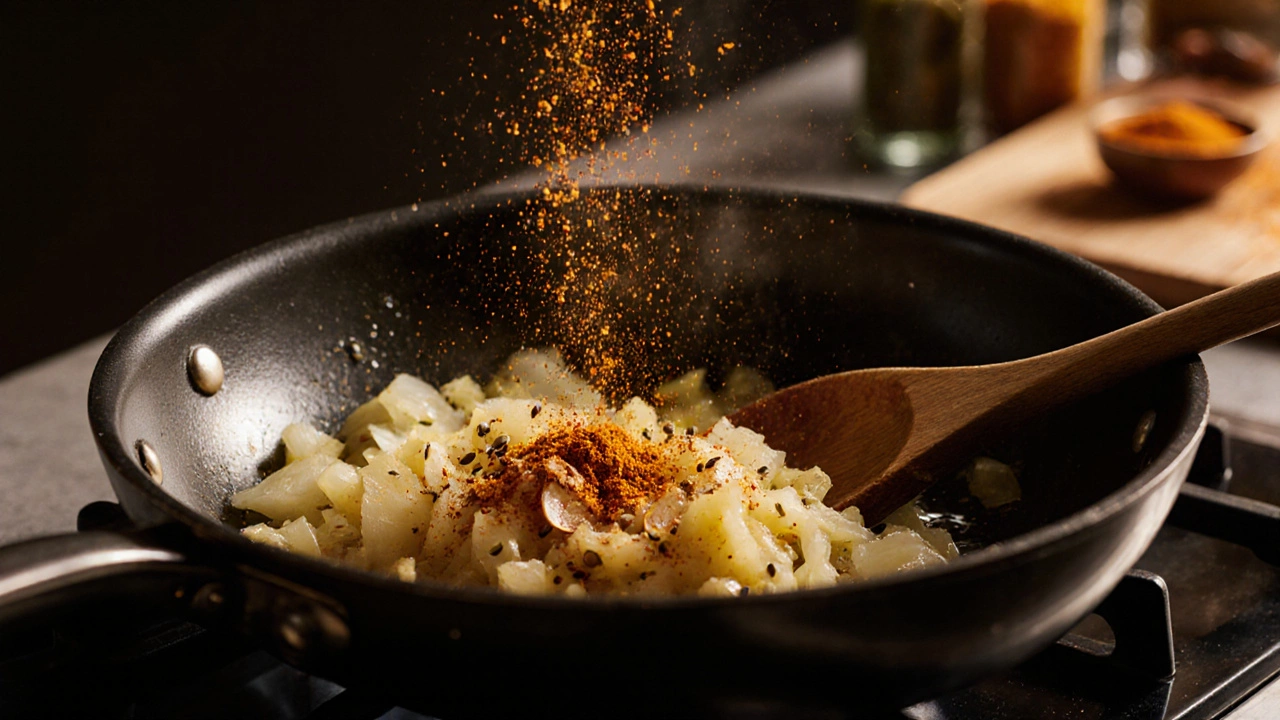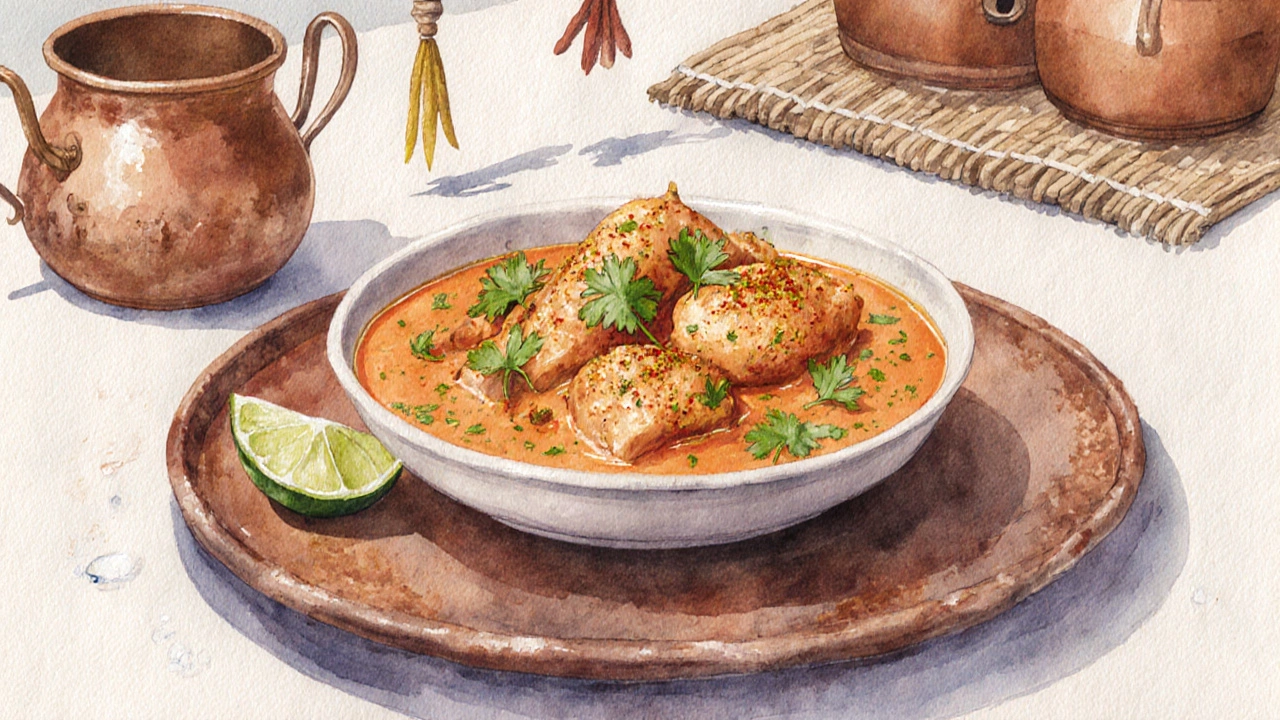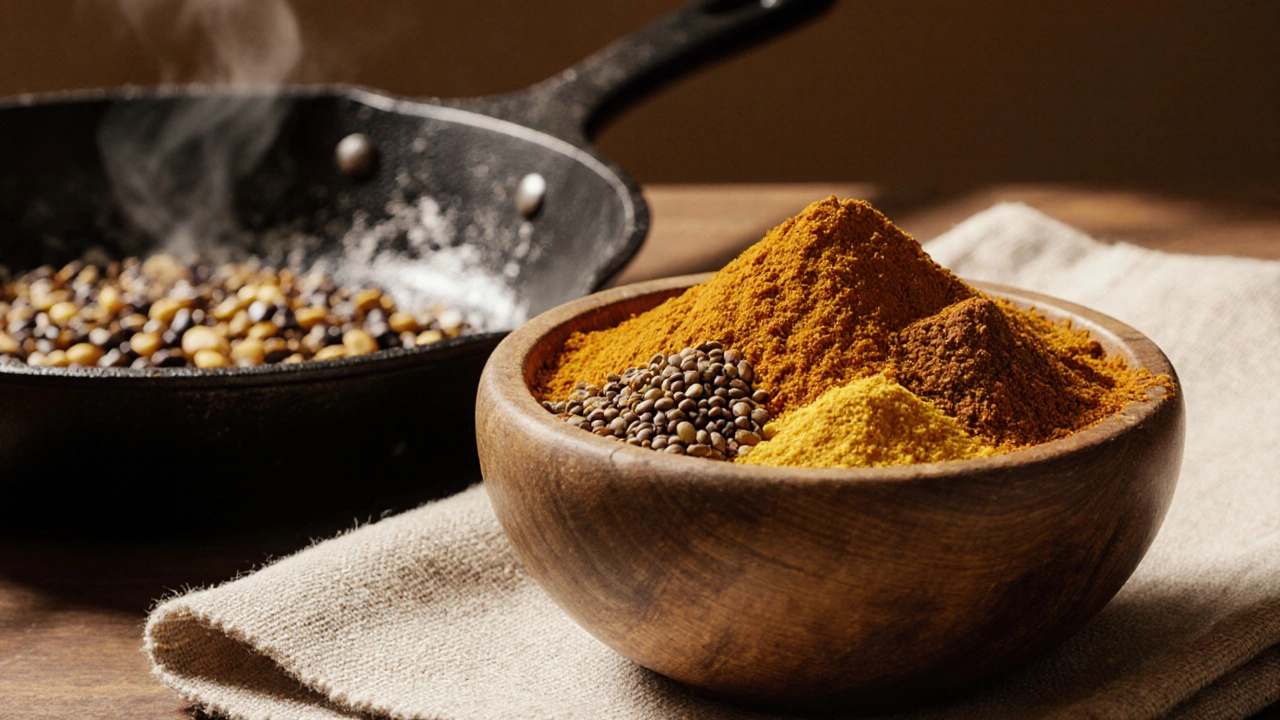When you hear the word curry is a savory sauce or stew that blends spices, aromatics, and liquids, originating from South Asia, you probably picture a bubbling pot of flavor. But what actually makes a curry taste like curry? Knowing the common curry ingredients helps you recreate that signature profile whether you’re cooking a quick chicken curry or experimenting with vegetables.
Why Understanding Ingredients Matters
Most home cooks follow a recipe and never look beyond the list of items. Yet every great curry follows a similar structure: a spice base, an aromatic foundation, and a liquid medium. Grasping this structure lets you adjust heat, swap proteins, or turn a recipe gluten‑free without starting from scratch.
Core Spice Blend: The Heart of the Curry
Traditional Indian curries rely on a handful of ground spices that create depth, color, and aroma. These spices are often toasted before grinding to unlock their flavors.
- Turmeric adds a bright golden hue and earthy bitterness
- Cumin provides warm, nutty notes
- Coriander offers citrus‑like freshness
- Fenugreek delivers a slightly sweet, maple‑like flavor
- Mustard seeds pop when fried, giving a sharp, peppery bite
Many regional dishes combine these into a pre‑made mix called garam masala a warm spice blend added toward the end of cooking. While garam masala varies by household, it almost always contains the five spices above plus cloves, cardamom, or cinnamon.
Aromatics: The Flavor‑Building Layer
Aromatics are the ingredients you sauté at the start. They soften, release sugars, and create a fragrant base that carries the spices throughout the dish.
- Onion provides sweetness and body when caramelized
- Garlic adds pungent depth
- Ginger contributes zing and helps balance heat
- Green chilies optional, for extra spice
Finely chopping or blending these before frying ensures they meld with the oil, creating a glossy coating that keeps the spices from burning.
Liquid Medium: The Sauce Builder
After the spice‑aromatic combo is ready, you introduce a liquid that carries the flavors and determines the curry’s texture.
- Tomato puree offers acidity and a slight sweetness
- Yogurt adds creaminess and a gentle tang; must be stirred in low heat to avoid curdling
- Coconut milk gives a rich, tropical body, perfect for South Indian styles
- Chicken stock enhances savory depth, especially in meat‑based curries
The choice of liquid often reflects regional preferences: North Indian curries lean toward dairy (yogurt, cream), while South Indian versions favor coconut milk.

Optional Extras: Fine‑Tuning the Profile
Beyond the core layers, chefs sprinkle in finishing touches that make each curry unique.
- Curry leaves release a piney aroma when fried
- Tamarind paste adds a sweet‑sour punch
- Fresh cilantro brightens the dish at the end
- Ghee clarified butter used for frying, contributing richness
Putting It All Together: A Simple Chicken Curry Example
- Heat 2tablespoons of ghee in a heavy‑bottomed pan. Add 1teaspoon mustard seeds; wait until they pop.
- Add 1 finely chopped onion. Cook over medium heat until golden‑brown (about 8minutes).
- Stir in 2cloves minced garlic and 1inch grated ginger; sauté 1minute.
- Mix in 1tablespoon each of turmeric, cumin, coriander, and fenugreek. Toast for 30seconds, stirring constantly.
- Pour in 200ml tomato puree and cook until the oil separates (≈5minutes).
- Add 500g chicken pieces, coating them in the spice‑onion mixture. Brown lightly.
- Pour in 300ml chicken stock and 150ml coconut milk. Bring to a gentle simmer.
- Cover and cook 15-20minutes, or until chicken is tender.
- Finish with 1teaspoon garam masala and a handful of chopped cilantro. Adjust salt.
This method showcases the three‑layer structure while leaving room for variations-swap coconut milk for yogurt, or use paneer instead of chicken.
Common Pitfalls and How to Avoid Them
- Burnt spices: Always cook spices on low-medium heat and add a splash of liquid if they start to stick.
- Thin sauce: Reduce the liquid by simmering uncovered, or add a spoonful of ground cashew paste for body.
- Over‑spicing: Measure spices accurately; remember that flavor intensifies as the curry simmers.
- Curdled yogurt: Temper yogurt with a bit of warm sauce before stirring it in, and keep the heat low.

Quick Checklist Before You Start
- All dry spices toasted and ready.
- Aromatics chopped uniformly.
- Liquid base measured (stock, tomato, dairy).
- Protein pre‑seasoned (salt, optional lemon).
- Fresh garnish (cilantro, lime wedges) on hand.
How to Adapt the Ingredient List for Different Diets
If you’re cooking vegan, replace chicken with chickpeas or tofu, use vegetable stock, and stick with coconut milk or almond yogurt. For a low‑fat version, swap ghee for a teaspoon of oil and omit cream.
| Category | Key Items | Primary Function | Typical Amount (per 4 servings) |
|---|---|---|---|
| Spice Base | Turmeric, Cumin, Coriander, Fenugreek, Mustard seeds | Color, depth, aroma | 1‑2tsp each |
| Aromatics | Onion, Garlic, Ginger, Green chilies | Sweetness, pungency, heat | 1large onion, 3cloves garlic, 1inch ginger |
| Liquid Medium | Tomato puree, Yogurt, Coconut milk, Stock | Body, acidity, creaminess | 200ml tomato, 150ml yogurt or coconut milk, 300ml stock |
| Finishing Touches | Garam masala, Cilantro, Curry leaves, Lime | Freshness, final aroma | 1tsp garam masala, handful cilantro |
Frequently Asked Questions
What makes a curry “Indian” versus “Thai”?
Indian curries rely heavily on a dry spice blend (like garam masala) and often use dairy or coconut milk, while Thai curries are built around fresh chilies, herbs (lemongrass, kaffir lime), and coconut milk as the primary base.
Can I make a curry without any powdered spices?
Yes. Fresh spice pastes (ginger‑garlic‑chili, roasted cumin‑coriander) can replace ground spices, but you’ll need to adjust quantities to achieve the same depth.
Why does my yogurt‑based curry sometimes split?
The proteins in yogurt coagulate when exposed to high heat. Temper the yogurt with a little warm sauce, then stir it in over low heat and avoid boiling.
How much chili should I add for a mild curry?
Start with ½ teaspoon of ground red chili or one small slit green chili. Taste after 10minutes and increase gradually; the heat builds as the sauce reduces.
Is it okay to freeze leftover curry?
Absolutely. Cool the curry quickly, store in airtight containers, and use within 2months. Reheat gently; avoid rapid boiling to keep the sauce smooth.
